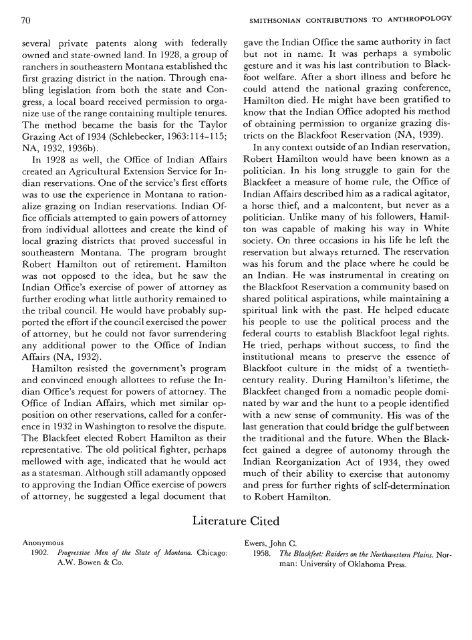Plains Indian Studies - Smithsonian Institution Libraries
Plains Indian Studies - Smithsonian Institution Libraries
Plains Indian Studies - Smithsonian Institution Libraries
You also want an ePaper? Increase the reach of your titles
YUMPU automatically turns print PDFs into web optimized ePapers that Google loves.
70 SMITHSONIAN CONTRIBUTIONS TO ANTHROPOLOGY<br />
several private patents along with federally<br />
owned and state-owned land. In 1928, a group of<br />
ranchers in southeastern Montana established the<br />
first grazing district in the nation. Through enabling<br />
legislation from both the state and Congress,<br />
a local board received permission to organize<br />
use of the range containing multiple tenures.<br />
The method became the basis for the Taylor<br />
Grazing Act of 1934 (Schlebecker, 1963:114-115;<br />
NA, 1932, 1936b).<br />
In 1928 as well, the Office of <strong>Indian</strong> Affairs<br />
created an Agricultural Extension Service for <strong>Indian</strong><br />
reservations. One of the service's first efforts<br />
was to use the experience in Montana to rationalize<br />
grazing on <strong>Indian</strong> reservations. <strong>Indian</strong> Office<br />
officials attempted to gain powers of attorney<br />
from individual allottees and create the kind of<br />
local grazing districts that proved successful in<br />
southeastern Montana. The program brought<br />
Robert Hamilton out of retirement. Hamilton<br />
was not opposed to the idea, but he saw the<br />
<strong>Indian</strong> Office's exercise of power of attorney as<br />
further eroding what little authority remained to<br />
the tribal council. He would have probably supported<br />
the effort if the council exercised the power<br />
of attorney, but he could not favor surrendering<br />
any additional power to the Office of <strong>Indian</strong><br />
Affairs (NA, 1932).<br />
Hamilton resisted the government's program<br />
and convinced enough allottees to refuse the <strong>Indian</strong><br />
Office's request for powers of attorney. The<br />
Office of <strong>Indian</strong> Affairs, which met similar opposition<br />
on other reservations, called for a conference<br />
in 1932 in Washington to resolve the dispute.<br />
The Blackfeet elected Robert Hamilton as their<br />
representative. The old political fighter, perhaps<br />
mellowed with age, indicated that he would act<br />
as a statesman. Although still adamantly opposed<br />
to approving the <strong>Indian</strong> Office exercise of powers<br />
of attorney, he suggested a legal document that<br />
Anonymous<br />
1902. Progressive Men of the State of Montana. Chicago:<br />
A.W. Bowen & Co.<br />
Literature Cited<br />
gave the <strong>Indian</strong> Office the same authority in fact<br />
but not in name. It was perhaps a symbolic<br />
gesture and it was his last contribution to Blackfoot<br />
welfare. After a short illness and before he<br />
could attend the national grazing conference,<br />
Hamilton died. He might have been gratified to<br />
know that the <strong>Indian</strong> Office adopted his method<br />
of obtaining permission to organize grazing districts<br />
on the Blackfoot Reservation (NA, 1939).<br />
In any context outside of an <strong>Indian</strong> reservation,<br />
Robert Hamilton would have been known as a<br />
politician. In his long struggle to gain for the<br />
Blackfeet a measure of home rule, the Office of<br />
<strong>Indian</strong> Affairs described him as a radical agitator,<br />
a horse thief, and a malcontent, but never as a<br />
politician. Unlike many of his followers, Hamilton<br />
was capable of making his way in White<br />
society. On three occasions in his life he left the<br />
reservation but always returned. The reservation<br />
was his forum and the place where he could be<br />
an <strong>Indian</strong>. He was instrumental in creating on<br />
the Blackfoot Reservation a community based on<br />
shared political aspirations, while maintaining a<br />
spiritual link with the past. He helped educate<br />
his people to use the political process and the<br />
federal courts to establish Blackfoot legal rights.<br />
He tried, perhaps without success, to find the<br />
institutional means to preserve the essence of<br />
Blackfoot culture in the midst of a twentiethcentury<br />
reality. During Hamilton's lifetime, the<br />
Blackfeet changed from a nomadic people dominated<br />
by war and the hunt to a people identified<br />
with a new sense of community. His was of the<br />
last generation that could bridge the gulf between<br />
the traditional and the future. When the Blackfeet<br />
gained a degree of autonomy through the<br />
<strong>Indian</strong> Reorganization Act of 1934, they owed<br />
much of their ability to exercise that autonomy<br />
and press for further rights of self-determination<br />
to Robert Hamilton.<br />
Ewers, John C<br />
1958. The Blackfeet: Raiders on the Northwestern <strong>Plains</strong>. Norman:<br />
University of Oklahoma Press.

















